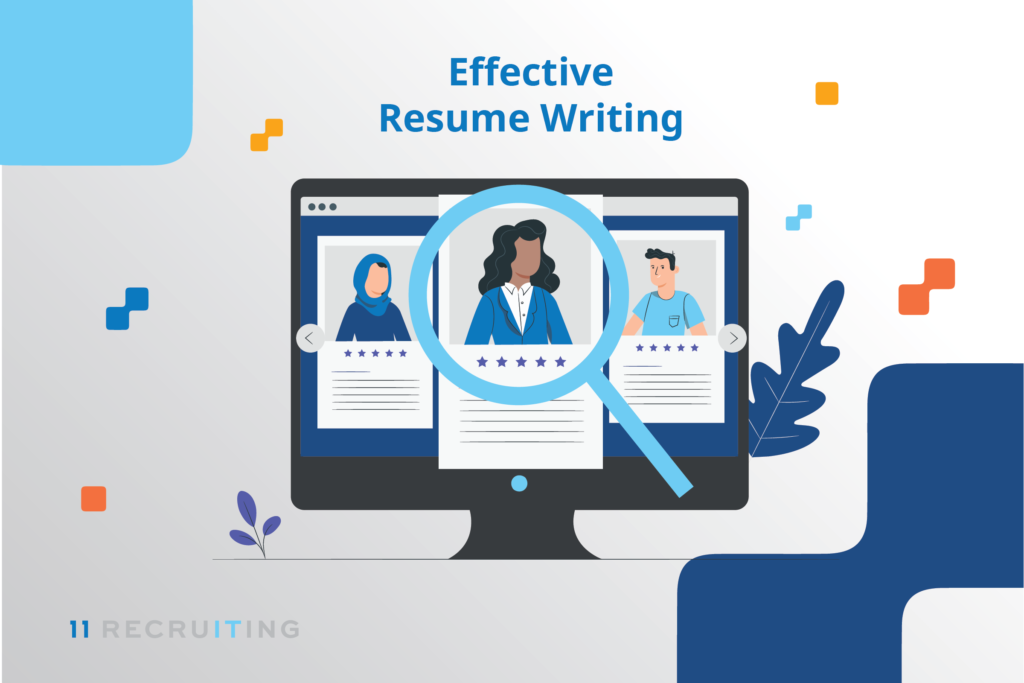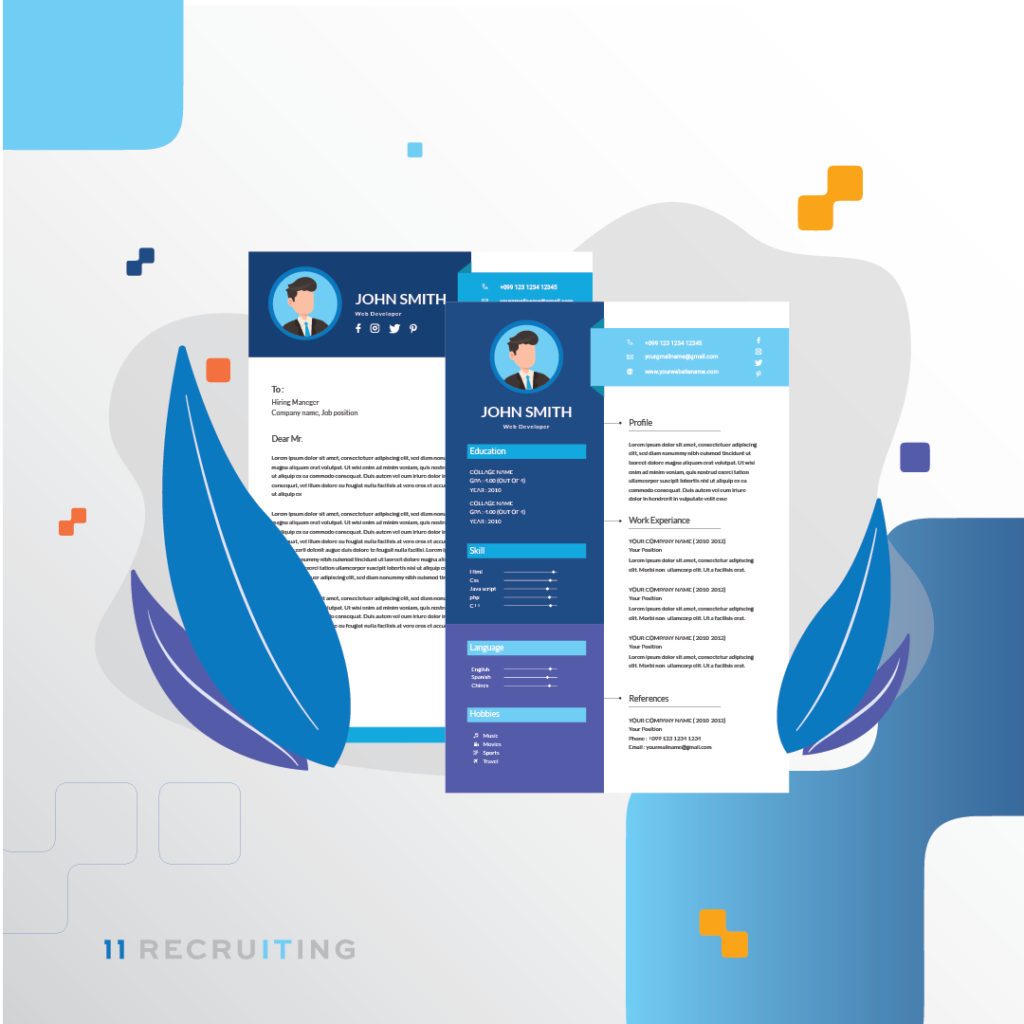
Your IT resume has only 7 seconds to make an excellent first impression, and that’s why it takes more than your qualifications to land a job. You may know your way around the most complex tech systems, have all the right IT skills, and even be the best person for that position, but if your resume doesn’t reflect all of that, that’s bye-bye.
You must note that recruiters use resumes to screen out candidates at the initial interview stage. So do you need a professional touch on your IT resume? Yes! Having an effective résumé increases your likelihood for further consideration.
Why Is An Effective IT Résumé Important
Your IT résumé communicates your education, work experience, and your IT skills to the recruiter. It also tells the recruiter how your qualifications fit into the role you’re applying to and how well you can perform the responsibilities required. In essence, an effective IT résumé catches the attention of your hiring manager and keeps you from getting screened out.
Whether you are looking for part-time or full-time work, internship, or considering changing your career path, this article will give you tips to tailor your IT résumé to be as effective and professional as it should be.
Frequently Asked Questions
Is it okay to have a 2-page résumé?
You can have a résumé that’s up to two pages only if you’ve got the relevant experience to back it up. Usually, this applies to applicants with 5-10 years of relevant experience in the field. As an entry-level IT candidate with less than five years of experience, a one-page résumé is ideal and works best for any IT job as long as it shows all your work experiences.
What should I include in a résumé objective or summary?
A professional IT résumé summary should have at most 3-4 sentences. The first sentence should tell of your years of relevant IT experience and your prime responsibilities as a tech person. Make sure to start the first sentence with a power keyword obtained from the job description. The second sentence should include your top IT accomplishment, and the third should describe the skills that highlight your IT abilities.
If you have no experience, your entry-level IT résumé objective can also include 3-4 sentences. The first sentence should hold an adjective of your current status (student or jobseeker), your CGPA, and any relevant experience (if you have one). Your second sentence should tell of your relevant IT skills and how those skills helped you achieve success. The third sentence should mention your other tech skills, achievements, or experiences that make you the ideal candidate for the job.
What are some common technical and soft skills for IT jobs?
Some IT skills résumé examples for IT jobs:
Technical/Hard Skills
- Agile Development
- Cloud Management
- Database Administration
- Data Synchronization
- UI / UX
- Analytical Skills
- Front-End & Back-End Development
Soft Skills
- Time Management
- Multitasking
- Analytical Skills
- Teamwork
- Creativity
- Problem Solving
Tips On Writing An IT Professional Résumé

Use the proper IT résumé format.
You need to catch the IT manager’s attention starting with the first thing they notice – Your tech résumé format. There are two types:
- The Reverse-chronological Format: This tech résumé emphasizes your recent IT work positions or current employment first, with previous IT work history listed below. This résumé is the best format if you have experience working in the tech industry, if your career progression has been steady, or if you don’t have gaps in your employment history.
- The Functional Format: This resume format focuses more on your skills than your experience or work history. Here’s the problem though, most recruiters hate this resume format because it doesn’t tell them your relevant qualifications and job titles, the highest level of responsibility you reached, and where and when you developed your skills. This IT résumé is ideal if you’re an entry-level applicant, have no work experience, or have gaps in your work history. It only shows off your IT skill set and your educational area.
I suggest you use the reverse-chronological format because most recruiters prefer them, and they are easier to scan for the ATS.
Have an Up-To-Date Contact Information.
How annoyed do you get when you try to reach someone over the phone a couple of times, and all you get is a voice message saying: this number doesn’t exist or is not reachable. Now imagine your interviewer going through the same thing. So, keep your contact information relevant and current.
Include your full name, current home address, and a professional email address that you have access to 24hrs. Your phone number should be working well, and any link to your LinkedIn or online portfolio should be valid.
Avoid using nicknames, adding your age, marital status, religion, or race. The recruiter doesn’t need to do any of those. And sometimes, they don’t wish to see your face at that point so, don’t bother with adding photos.
Have a Juicy Résumé Profile.
Your résumé is the first section the recruiter will give attention to when reading, and they’ll use that to measure you up. So, if it doesn’t get them captivated, then the rest of your résumé won’t make much of a difference. Your résumé profile will show the hiring manager if you’ve done your homework about the company, the job description, and what you can offer.
It will also show if you have a defined and realistic goal or if you’re someone that’ll do any work for the paycheck. Now, there are two standard types of résumé profiles:
Your résumé summary; This is a more holistic overview of you, your tech work experience, IT skills, and job expertise. If you have a lot of IT work experience, this résumé summary is ideal.
Here’s an example:
Energetic IT Project Manager with 8+ years of experience in planning, controlling, executing, and closing various IT projects. Managed all phases of $14M deployment of CMS for Eleven Recruiting, and closed before deadline. Achieved 70% process time savings through implementing process automations and IT upgrades at TC resource. Keen to leverage expertise at Apple Inc.
Your résumé objective; This tells the hiring manager about your general knowledge, skills, and career aspirations rather than your IT work experience. So, if you’re an entry-level aspirant or you’re thinking of a career switch, this statement would fit well for your IT résumé.
Here’s an example:
Passionate IT graduate from the Illinois Institute of Technology with 5 months of experience in database administration. Seeking to use proven skills in JavaScript and C++ to meet business plans at Apple Inc.
Whichever one you’re going for, make sure to do your research well and try as much as possible to tailor it to what the IT firm does. Find out the current trends in technology that’s changing the IT industry and the most in-demand qualifications.
Research the position you want, and yes, you may not know most of the job details until the face-to-face or zoom interview. Nonetheless, any crumps of fact you can get, use the keywords to target your IT résumé profile.
Add Relevant Work Experience.
For your IT professional résumé, your work experience has to be strong because this is the section that’ll show the recruiter what you’ve done in the past and the results that came from it.
So, make sure you list the most current job and go back in time with your experience (use the chronological resume format to help you with this). Add a professional job title/position, the company name and location, and key responsibilities. And, make sure to list your key responsibilities in bullet points.
Use numbers to tell and prove your success. For example: Deployed a tech strategy that gave a 97.9% ROI is better than Deployed a tech strategy that doubled our success. Also, when inputting your work experience, the first 3-5 yrs in your job history is crucial. You don’t need to check the recruiter with work experience from way back 10 yrs ago (especially if you’re a pro applying for a senior level).
Use The Right and Applicable IT skills.
Your IT skills need to be relevant to the job descriptions. It also means that you don’t need to pack irrelevant skills to make a long list on your resume, it’s a major turn-off for most recruiters.
Make sure you add both technical skills and soft skills to the list. Check for the IT skills keywords in the job descriptions and use them in your resume. An ATS system will scan your resume for those keywords to check if you have the right skills (from the job description) for the job.
Add A Correct And Traceable Education.
This section is the shortest in your résumé and should make a good impression. If you’re a professional, recruiters wouldn’t want to know your high school or college of over 20 yrs. You only need to add your Degree/Diploma, the school name, location, and completed date.
If you’re an entry-level applicant, add your degree, your school name and location, and your completed date or expected graduation date. Now, most people get confused about what should come first, your education or your experience? If possible, your experience should come before your education, especially if you’re a professional. For an entry-level applicant, your educational background is your strong selling point.
Be Smart With Your Additional Information Section.
Additional sections always give you extra points and standings with the recruiter. This additional section can house your IT achievements, relevant coursework certifications, hobbies and interests, languages, or volunteering services. Make sure that these subheadings in your additional skills are relevant and they fit the job descriptions.
For instance, when applying for an IT job, the recruiter doesn’t want to know that your hobby or interest is in watching movies or playing with your dog. Instead, you could add that you like to take extra courses or read tech books or magazines. This way, you’re telling the recruiter that you make an effort to grow your knowledge as a hobby.
Add Relevant Links.
As an IT applicant, you should have links that could take your recruiters to URLs that have either your portfolio or proof of recent projects you’ve done. Add those links to your résumé and make sure they are clickable and not broken.
Now that you know how to write an effective IT résumé, all you need to do is practice these tips and proofread to make sure your résumé is free from grammatical errors. Don’t forget that you’ll also need a great cover letter that matches your résumé. Doing this will give you an advantage over other candidates.
To sum up…
Make sure you tailor your résumé to the job application and that you have the correct contact info, relevant skills, and job experience. Don’t forget, your profile summary must hold the job keywords and phrases. Your educational background and additional information must also be relevant and up to date.
Remember, your executive IT résumé is only one aspect of the job search. Other factors go into your job search, like targeting the right companies and positions, networking, and nailing your interview. Good luck!
Wondering if your resume gets into the hands of a hiring manager? We can help you out

